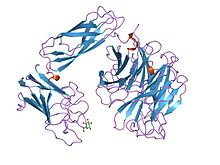| BNR/Asp-box repeat | |||||||||||
|---|---|---|---|---|---|---|---|---|---|---|---|
 Structure of a bacterial sialidase.
[1] | |||||||||||
| Identifiers | |||||||||||
| Symbol | BNR | ||||||||||
| Pfam | PF02012 | ||||||||||
| Pfam clan | CL0434 | ||||||||||
| InterPro | IPR002860 | ||||||||||
| SCOP2 | 1euu / SCOPe / SUPFAM | ||||||||||
| |||||||||||
Bacterial neuraminidase is type of neuraminidase and a virulence factor for many bacteria including Bacteroides fragilis and Pseudomonas aeruginosa. Its function is to cleave a sialic acid residue off ganglioside- GM1 (a modulator of cell surface and receptor activity) turning it into asialo-GM1 to which type 4 pili (attachment factors) bind preferentially.
References
- ^ Gaskell A, Crennell S, Taylor G (November 1995). "The three domains of a bacterial sialidase: a beta-propeller, an immunoglobulin module and a galactose-binding jelly-roll". Structure. 3 (11): 1197–205. doi: 10.1016/s0969-2126(01)00255-6. PMID 8591030.
| BNR/Asp-box repeat | |||||||||||
|---|---|---|---|---|---|---|---|---|---|---|---|
 Structure of a bacterial sialidase.
[1] | |||||||||||
| Identifiers | |||||||||||
| Symbol | BNR | ||||||||||
| Pfam | PF02012 | ||||||||||
| Pfam clan | CL0434 | ||||||||||
| InterPro | IPR002860 | ||||||||||
| SCOP2 | 1euu / SCOPe / SUPFAM | ||||||||||
| |||||||||||
Bacterial neuraminidase is type of neuraminidase and a virulence factor for many bacteria including Bacteroides fragilis and Pseudomonas aeruginosa. Its function is to cleave a sialic acid residue off ganglioside- GM1 (a modulator of cell surface and receptor activity) turning it into asialo-GM1 to which type 4 pili (attachment factors) bind preferentially.
References
- ^ Gaskell A, Crennell S, Taylor G (November 1995). "The three domains of a bacterial sialidase: a beta-propeller, an immunoglobulin module and a galactose-binding jelly-roll". Structure. 3 (11): 1197–205. doi: 10.1016/s0969-2126(01)00255-6. PMID 8591030.